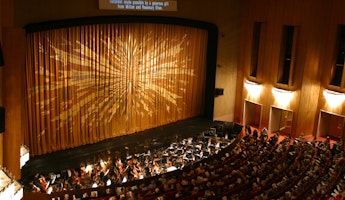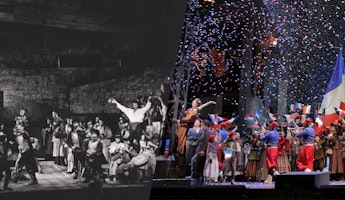Blog
June 24, 2024
Gounod & Shakespeare: Artistic Masters
Early and late in his career, Shakespeare wrote about all-consuming passion. Romeo and Juliet is a domestic drama about the reckless, headstrong love of teenagers; Antony and Cleopatra deals with a world-weary historical couple whose romance plays out on a vast stage and alters the course of history. Although the later play is a far superior work of art, the story of the children of fair Verona is the one that has captured the hearts of millions through the ages, and has inspired retelling in every conceivable form: spoken theater, ballet, film, the Broadway musical, symphonic treatment and, many times over, in opera.
Although he wrote a good deal of music, Charles Gounod is primarily remembered for Faust, his operatic treatment of the great classic of German literature. The Germans thought little of his effort and always refer to his opera as Margarete, the woman Faust seduces (Gretchen in Goethe’s original). Eight years after Faust, in 1867, and with several more operas to his credit, Gounod brought out Romeo and Juliet, a work of outstanding musical and dramatic power. It deserves its own place in the operatic pantheon.
The music of an opera has to begin with a text, a story, an idea that gives a composer the impulse to expand and amplify beyond verbal limits to the fullness of dramatic communication that we call musical theater. (In Italy, the home of opera, the whole operatic project is called simply il teatro.) The librettists for Romeo, Barbier and Carré, were experienced at adapting literary texts for operatic use, having already served Gounod and other composers in that capacity. Naturally enough, they had to pare down Shakespeare’s text to a manageable size and they did a good, workmanlike job which is more than a sketch, if less than a literary masterpiece. But it served the purpose of stimulating Gounod to writing music of extraordinary romantic and dramatic scope.
The process by which a play of some thousands of lines is reduced to proportions suitable for an opera is instructive; the challenge consists of maintaining the basic outlines of the story as well as the overall concept of the original. Inevitably there will be compromises involving characters and situations; omissions will be necessary and may seem fatal to those familiar with the play. For example, the first scene takes place at the Capulets’ ball, omitting much of the exposition which serves to delineate the character of Shakespeare’s Romeo. But, as in the play, there is a prologue, here sung by the chorus, which does indicate the nature of the dispute between the two houses.
A major change and stumbling block might seem the survival of Romeo in the last scene so that the two lovers can sing their final duet. But in one of Shakespeare’s supreme works, Desdemona revives briefly after Othello has strangled her, and no one seems to be troubled by that. The willing suspension of disbelief sets in as soon as we accept three walls on any stage, and continues unabated.
Barbier and Carré are surely to be commended for the large elements in Romeo that correspond to Shakespeare’s unfolding of the plot and which give the opera its essential dramatic structure: the ball in the opening scene, the balcony scene, Romeo's duel with Tybalt and his condemnation to exile, the lovers’ parting, and the final scene in the tomb. Each of these segments is clothed in music of outstanding dramatic quality and, at times, of musical genius. The major characters come across as fully believable persons of the drama, and the central idea of the star-crossed lovers is amply presented: when hatred and violence are given their head, love is destroyed and tragedy ensues.
As in the play, the prologue presents the basic outline of the story and the music adds its unique descriptive and suggestive element. At the start, the orchestra led by the brass depicts the raging conflict of the opposing families, but then we hear the love theme which will recur so affectingly at key moments later in the opera.
Romeo enters with his friends and we recognize his sensitive, almost timid unwillingness to arouse the hostility of his hosts, as contrasted with the brash behavior of Mercutio. What really matters in this scene is the vivacity of Juliet revealed in her famous Waltz Song and the ensuing duet when the lovers first meet. The French text of the duet has none of the incomparable grace of the sonnet Shakespeare gives them, but the music has its own charm and easily establishes the powerful attraction that draws them together. There is no suggestion of raging hormones in this music; it is a depiction of tentative exploration, of gradual dawning of completely new emotion. These two are little more than children and they are happily embarking on a voyage of discovery, completely oblivious of its final tragic ending.
The balcony scene begins with an orchestral prelude that evokes the lush warmth of the Italian night; the strings weave a delicious web of yearning that prepares us for Romeo's apostrophe to the night and the stars. Juliet for him is the brilliant sun that puts the stars to shame. In this version we miss Shakespeare’s wonderful trope:
Two of the fairest stars in all the heaven,
Having some business, do entreat her eyes
To twinkle in their spheres till they return.
But the ardent lyricism of Romeo's music makes up for it; small wonder that this is one of the arias that every tenor dreams of singing, and inevitably it brings down the house.
The love duet portrays the advance from their first meeting to a rapid, tempestuous passion that leads to the promise of marriage and the eager longing for the night to end and bring the longed for union of the following day. The scene ends as it began, with Romeo alone, imagining Juliet sleeping like a child and praying that the soft night breezes will whisper in her ear his goodnight kiss. He sings almost the whole text on a single note, while the orchestra weaves around him a web of rich chromatic sound, and with him fades to silence at his final words, “ce baiser” — this kiss.
This wedding before Friar Laurence is quickly dispatched and the quiet romanticism of the balcony scene gives way to the violent uproar of the duel between Romeo and Tybalt and the ensuing decree of Romeo's exile. The librettists have combined several elements of the play: after Romeo kills Tybalt he does not flee as in Shakespeare but remains to hear the Duke’s decree of exile. The librettists insert here the cry Shakespeare wrote for the Nurse at discovering the seemingly dead Juliet —“Most lamentable day, most woeful day” — and it becomes the central text of the great concertato scene that follows: “Ah, jour de deuil, et d’horreur, et d’alarmes.” Romeo begins it solo and it is taken up by the whole ensemble with a powerful orchestral accompaniment. This is one of those concepts in opera that often baffle those accustomed only to spoken theater. How can a large group of singers declaim all at once and make sense of the various sentiments they want to convey? With this great music, the composer gives an outstanding example of the value of this dramatic convention. Everyone concerned laments what has happened: the cause of Romeo's outburst is the Duke’s decree of Romeo's exile; the blame lies not only with Romeo but with the two warring houses which have brought grief on the whole city. In a masterful stroke the composer has combined the personal tragedy of the two lovers with the terrible social effect of their families’ mutual hatred.
Two great scenes remain for the star-crossed lovers, the first in Juliet's bed chamber. They sing in gentle tones of the sweetness of their wedding night. The music reprises the sounds of the balcony scene with all its lyrical charm. It is developed into a full throated cry for both until Romeo interrupts in alarm. In Shakespeare the scene begins with Juliet’s rebuke,
Wilt thou be gone? It is not yet near day.
It was the nightingale, and not the lark
That pierced the fearful hollow of thine ear.
The librettists have turned this into words that admirably mimic the English and moves Gounod to one of his most inspired musical inventions. “Non, c’est de pas le jour…” Juliet begins, then repeats her plea to Romeo to stay; he relents and in his turn he sings Juliet's impassioned “non, ce n’est pas le jour.” It is a melody of extraordinary dramatic power that combines passionate longing and a desperate denial of the reality that with the coming of day all the lovers’ hopes will be dashed by exile, death and the destructive power of hate that will separate them forever. The music at this point is a culmination of everything the opera wishes to convey; its importance will be confirmed in the final, tomb scene.
After Romeo leaves, Juliet has an aria, once routinely cut, now happily restored, which admirably depicts the development of her character. Friar Laurence enters and gives her the potion which will simulate her death. She sings, “Amour, ranime mon courage” — o love, strengthen my resolve. She is afraid, but willing to do anything that will rejoin her to Romeo. The music here is no longer that of the carefree girl singing her waltz song. Young still in years but grown into the stature of a woman matured by suffering, Juliet has become a tragic heroine whose voice reflects both the height and the depth of her final state.
As in the play, everything goes wrong and Romeo believes that his beloved is really dead. The tomb scene in the opera eliminates all characters except the two lovers. Gounod has concentrated in these final moments all his powers of melodic invention and deeply felt sympathy for these two people. The music suggests that the composer really loves these characters and feels the sadness of their cruel end. Every page of the music is suffused with dramatic cogency that plumbs the depths of longing and sorrow that all of us sense in the needless death of the young: longing to avert catastrophe and the clear understanding that we cannot.
Two moments stand out in the exchanges between the two in this final scene. Romoe's words, “le rêve était trop beau,” our dream was all too fair, is clothed in music that achingly expresses the combination of hope and sorrow that have almost been the definition of the love of Romeo and Juliet. The other moment, even more poignant, is the recollection of that other parting when both of them desperately tried to stave off the pain of separation, “Non, non, ce n’est pas le jour” — it is not the day and the sound of the lark; it is the nightingale, protector of our love. That melody, so touching when first heard in the bedroom scene, returns now with a searing urgency that marks the composer not only as a canny dramatist but also as a deeply humane observer of lost love.
Critical judgments have their place. Shakespeare’s Romeo and Juliet is an early play and has the flaws of a writer not yet at the top of his game; the reliance on chance to advance the plot, e.g., Friar Laurence’s letter going astray, is not a good dramatic device. But if the play is a flawed work it is nevertheless the work of a genius who would grow astronomically in very short order. Gounod was a conservative composer, bound by the strict rules of 19th century romantic sensibility, yet he had a profound sense of the power of passionate love and found the musical means to give it glorious life.
At the end of the play the Duke laments that “never was a story of more woe / than this of Juliet and her Romeo.” Both the master of words and the master of music have assured that the story will never be forgotten.
Basil De Pinto, who writes frequently for LA Opera, has also written for the opera companies of Washington, D.C., Seattle, Atlanta and Fort Worth.








/03-cosi/_dsc0996_pr.jpg?format=auto&fit=crop&w=345&h=200&auto=format)

















